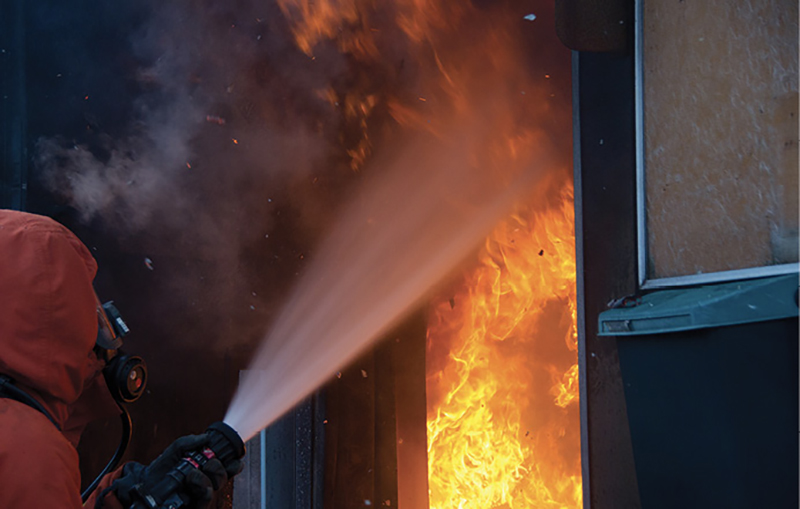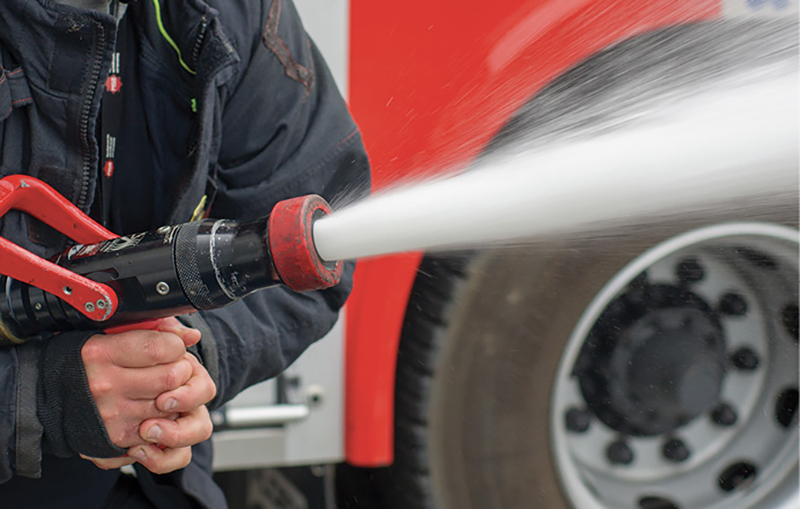BY STEFAN SVENSSON
The fire service is always looking for the “golden key,” that quick fix that works in every situation all the time. Unfortunately, there is no such golden key. We must find different solutions and equipment for different situations; that is what we are very good at.
- Fire Dynamics: There Is No Such Thing as Extreme Fire Behavior
- The Science of Firefighter Safety
- The Only Way to Firefighter Safety Is Through Knowledge
- The Fire Demonstration Chamber: Rethinking the Flashover Container
Firefighters are great problem solvers, but we must understand how our chosen equipment works. For putting out fires, we should know and understand how water works when used as a suppressing agent.
Heat Capacity
Water is an excellent suppressing agent because of its physical properties. Heat capacity is one such physical property, describing the amount of heat needed to change the temperature of a unit mass. This is very useful when putting out fires; we must remove the heat, reduce the temperature, and thus extinguish the fire. The heat capacity of water is one calorie per gram per degree Celsius (1 cal/g°C). It is also measured as one British thermal unit (Btu) per pound per degree Fahrenheit (1 Btu/lb°F), which is the equivalent to 4,180 Joules per kilogram per degree Celsius (4.18 kJ/kg°C). This is a lot of energy that can be absorbed just by heating up water; during firefighting, this heat comes from the fire.
The heat capacity of steam is 2 kJ/ kg°C, slightly less but still a lot. On top of this, the heat of vaporization (amount of energy needed to vaporize water) is 2,260 kJ/kg. This may also be expressed as 540,000 cal/kg or 970 Btu/lb. As a result of this, a flow rate of one liter of water per second can put out roughly three megawatts (MW) of fire, equivalent to a large recliner burning. One watt is equivalent to one Joule per second; one MW is one million watts. This enables us to compare the flow rate with the size of fire. The flow rate is definitely key—small fire, small water; big fire, big water. We are using water to absorb heat and thus reduce the temperature, which eventually will put the fire out. However, we must keep in mind that flow rate is only one of a large number of factors that affect the effectiveness of water in extinguishment.
Droplet Size
Another factor is the size of the droplets a nozzle produces. Small droplets have a larger surface area in relation to their volume than large droplets. Consequently, smaller droplets heat up and evaporate faster. Also, small droplets have less mass, which means that they will not travel as far as large droplets, assuming that they have the same initial velocity. Both size and mass make a difference when applying water to fire. Note that, from a scientific point of view, a straight stream can be considered as a very large continuous droplet.
Fire Suppression and Extinguishment
Five mechanisms are associated with suppression and extinguishment and are largely valid for any suppressing agent—in this case, water: gas phase cooling (which includes hot gases as well as flames), oxygen depletion and flammable vapor dilution (mainly on a molecular level), the wetting and cooling of the fuel surface, radiation attenuation (mainly on a molecular level), and kinetic effects.
Gas phase cooling happens when water droplets pass through flames or through hot fire gases. As smaller droplets heat up and evaporate faster, they will absorb heat faster when passing through a flame or a hot gas layer than large droplets. On the other hand, small droplets will also disappear faster (since they evaporate faster) and not travel as far as large droplets because they have less mass. Because of the same mechanism, water in the flames or fire gases will also work as “thermal ballast.”
Oxygen depletion and flammable vapor (fire gases) dilution happen when water evaporates in the fire gases. The steam generated will dilute the fire gases, displacing the oxygen and making the fire gases less flammable. Again, as the smaller droplets heat up and evaporate faster, they will dilute the fire gases, making them less flammable faster than larger droplets.
When the water hits the fuel, it will wet and cool it. Consequently, the pyrolysis or evaporation of flammable gases will decrease. Since large droplets travel farther because they have greater mass and a larger volume (they will heat up and evaporate more slowly than small droplets), the chance of the large droplets hitting the fuel is greater than for smaller droplets to do so. This is how fires are extinguished in most cases—by wetting and cooling the fuel.

(1) Fog streams are good for covering volume and surface, especially in smaller rooms. (Photos by author.)

(2) Straight streams are great when plenty of water is needed, especially at some distance or in larger spaces.
Also, water blocks radiation in the infrared spectrum very well. Since radiation from fires is largely in the infrared spectrum, blocking this radiation will decrease the feedback from the flames to the fuel, thus decreasing the pyrolysis or evaporation of flammable gases.
Finally, applying water has kinetic effects. As the droplets pass through air or hot gases, they will stir things around. The droplets might “pull” air in and thus add more air to the fire. This is of course is more appreciable for smaller droplets than for larger droplets, because smaller droplets have a larger surface area in relation to their volume than larger droplets. Also, the same volume of water will result in a larger number of small droplets than large ones. Consequently, small droplets have a larger kinetic effect when passing through fire gases or flames. The good thing with this kinetic effect is that it may cool the fire gases and the flames just by stirring things around.
Remember that none of these effects alone will put fires out; it’s always a combination of effects. But how much each one affects the fire depends on the situation and on how water is applied, among other things.
Nozzles
How does this relate to the use of smooth bores, fog nozzles, the flow rate, and the nozzle pressure? A straight stream primarily affects the fuel surface’s wetting and cooling (primarily but not exclusively). A fog nozzle produces droplets of various sizes (depending on the cone angle, the flow rate, and the pressure). Consequently, a fog nozzle affects all five mechanisms above to various degrees (depending on the cone angle, the flow rate, and the pressure) because the water is distributed in a larger volume of fire gas. Also, this depends to some degree on the droplet size.
Droplet size (consider a straight stream as a very large continuous droplet) affects how long the droplet will travel (because of evaporation, its initial velocity, its mass, and its “air resistance”). A smaller droplet evaporates faster but doesn’t necessarily travel that far. A larger droplet doesn’t evaporate very fast but it travels farther. A small droplet heats up faster than a large droplet. Consequently, gas cooling with larger droplets (or a straight stream) doesn’t work very well, unless we make smaller droplets out of larger droplets, such as by hitting a surface with the droplet so that it breaks up. However, it’s not really the same as producing a smaller droplet at the nozzle. Small droplets passing through a room filled with fire gases have a different effect than droplets produced at surfaces within the fire room. Such droplets don’t pass through the gases in the same way. On the other hand, large droplets are more effective at the target.
Note that gas cooling doesn’t put fires out, but it can enable us to safely and efficiently get to the target, the burning fuel. However, the larger the fire, the less effective gas cooling becomes because the droplets evaporate and the steam is more likely to flow out with the fire gases.
So, depending on what you want to achieve with your water application, you must choose which tool to use. A large flow rate is not always necessary or desired. To hit a larger fire at some distance, use a straight stream, usually combined with a larger flow rate. To attack a fire more delicately, use a fog nozzle and adjust the cone angle according to your need, assuming that the fire is fairly small. It also depends on the size of the room. Smaller droplets work better in smaller rooms; and large droplets (as in a straight stream) work better in larger room because they have a longer reach.
But it’s not an either/or question. Sometimes we need a larger flow, sometimes a smaller one; sometimes we need a straight stream, sometimes a fog; sometimes we need small droplets, sometimes large ones. It depends. But to make the best use of what we have, we must understand how the five mechanisms work.
One of the major mistakes we make, at least in Sweden, is that we tend to use the same tactics in every situation. For residential buildings, we use fog nozzles with fairly small flow rates, among other things, because residential buildings are heavily compartmentalized and fire resistant. Residential building tactics, however, are rarely useful in larger buildings with long corridors and high ceilings. Such environments usually require larger flow rates and especially a farther reach.
Remember that the environment and the operator have an impact too; we can’t take these parameters out of the equation!
We have to understand how each of the five mechanisms outlined above work. They work to various degrees, depending on the situation, the type of nozzle, the stage of water application, and so forth. Consequently, we need to know how our equipment works, understand the environments we work in, and have a fundamental knowledge of fire behavior in such environments.
STEFAN SVENSSON is an instructor at the Swedish Civil Contingencies Agency (MSB). A firefighter since 1986 and fire officer since 1990, he has served as firefighter/crew commander with his local fire brigade and is the regional on-scene commander in case of nuclear accidents. Svensson has a bachelor’s degree in fire safety engineering and a Ph.D. from Lund University (Sweden), where he is an associate professor. Since 1994, he has conducted investigations on firefighting tactics, methods, and command and control issues.

